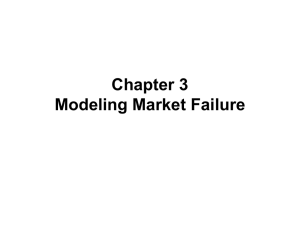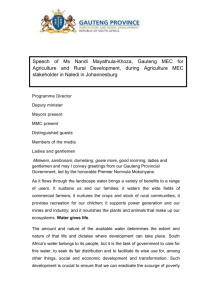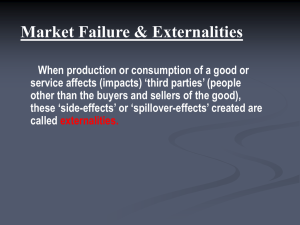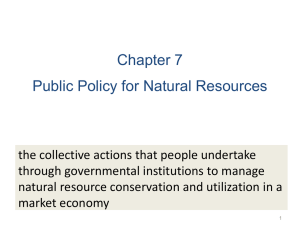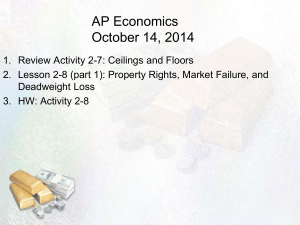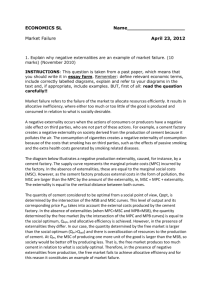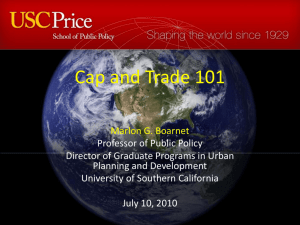Market Failure
advertisement
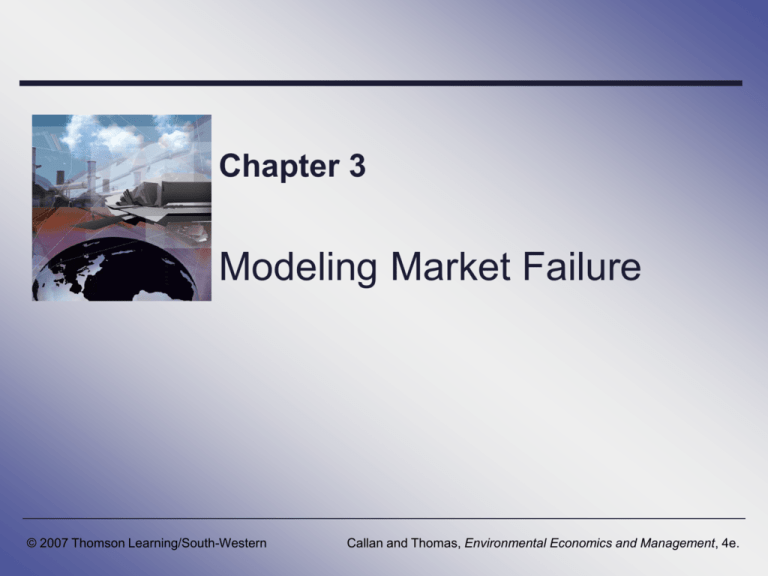
Chapter 3 Modeling Market Failure © 2007 Thomson Learning/South-Western Callan and Thomas, Environmental Economics and Management, 4e. Environmental Pollution A Market Failure Market failure is the result of an inefficient market condition Environmental problems are modeled as market failures using either the theory of public goods or the theory of externalities If the market is defined as “environmental quality,” then the source of the market failure is that environmental quality is a public good If the market is defined as the good whose production or consumption generates environmental damage, then the market failure is due to an externality 2 Public Goods Approach Environmental Quality A Public Good A public good is a commodity that is nonrival in consumption and yields nonexcludable benefits Nonrivalness – the characteristic of indivisible benefits of consumption such that one person’s consumption does not preclude that of another Nonexcludability – the characteristic that makes it impossible to prevent others from sharing in the benefits of consumption The relevant market definition is the public good – environmental quality, which possesses these characteristics 4 A Public Goods Market for Environmental Quality Public goods generate a market failure because the nonrivalness and nonexcludability characteristics prevent market incentives from achieving allocative efficiency Achieving allocative efficiency in a public goods market depends on the existence of well-defined supply and demand functions But the public goods definition disallows the conventional derivation of market demand 5 Market Demand for a Public Good In theory, market D for a public good is found by vertically summing individual demands Vertical sum because we must ask consumers “What price would you be willing to pay for each quantity of the public good?” But consumers are unwilling to reveal their WTP because they can share in consuming the public good even when purchased by someone else Due to the nonrival and nonexcludability characteristics This problem is called nonrevelation of preferences, which arises due to free-ridership 6 Market Demand for a Public Good Result is that market demand is undefined In addition, lack of awareness of environmental problems (i.e., imperfect information) exacerbates the problem Consequently, allocative efficiency cannot be achieved without third-party intervention 7 Solution to Public Goods Dilemma Government Intervention Government might respond through direct provision of public goods Government might use political procedures and voting rules to identifying society’s preferences about public goods 8 Externality Approach Environmental Problems A Negative Externality An externality is a spillover effect associated with production or consumption that extends to a third party outside the market Negative externality – an external effect that generates costs to a third party Positive externality – an external effect that generates benefits to a third party 10 Environmental Problems A Negative Externality Environmental economists are interested in externalities that damage the atmosphere, water supply, natural resources, and overall quality of life To model these environmental externalities, the relevant market must be defined as the good whose production or consumption generates environmental damage outside the market transaction 11 Relationship Between Public Goods and Externalities Although public goods and externalities are not the same concept, they are closely related If the externality affects a broad segment of society and if its effects are nonrival and nonexcludable, the externality is itself a public good If the externality affects a narrower group of individuals or firms, those effects are more properly modeled as an externality 12 Modeling a Negative Environmental Externality Define the market as refined petroleum Assume the market is competitive Supply is the marginal private cost (MPC) Demand is the marginal private benefit (MPB) Production generates pollution, modeled as a marginal external cost (MEC) Problem: Producers (refineries) have no incentive to consider the externality Result: Competitive solution is inefficient 13 Finding a Competitive Solution Refined Petroleum Market (text example) S: D: P = 10.0 + 0.075Q P = 42.0 - 0.125Q, where Q is thousands of barrels per day Since S is MPC and D is MPB, rewrite as: MPC = 10.0 + 0.075Q MPB = 42.0 - 0.125Q Find the competitive solution and analyze 14 Competitive Solution Set MPB = MPC 42.0 - 0.125Q = 10.0 + 0.075Q Solve: QC = 160 thousand PC = $22 per barrel Analysis: This ignores external costs from contamination Allocative efficiency requires P to equal all MC MPC undervalues opportunity costs of production; QC is too high; PC is too low 15 Finding an Efficient Solution Refined Petroleum Market Let Marginal External Cost (MEC) = 0.05Q Marginal Social Cost (MSC) = MPC + MEC MSC = 10.0 + 0.075Q + 0.05Q = 10.0 + 0.125Q Marginal Social Benefit (MSB) = MPB + MEB Assuming no external benefits, MEB= 0, so MSB = MPB Find the efficient solution; show graphically 16 Efficient Solution Set MSC = MSB 10.0 + 0.125Q = 42.0 - 0.125Q Solving: QE = 128 thousand PE = $26/barrel Observe: In the presence of an externality, market forces cannot determine an efficient outcome 17 P per barrel MSC, MPC, MPB Graph 42 MSC = MPC + MEC S =MPC PE = 26 PC = 22 10 D = MPB = MSB 0 128 QE 160 QC Q (thousands) Observations Results of negative externality QC is too high, i.e., overallocation of resources PC is too low, since MEC is not captured by market transaction 19 Comparing the Equilibria Using M and MEC Competitive firm maximizes where MPB = MPC, or where MPB - MPC = 0, or M = 0 since MPB – MPC = M by definition Efficient firm produces where MSB = MSC or MPB + MEB = MPC + MEC or MPB - MPC = MEC, if MEB = 0, so… M = MEC 20 Model Refined Petroleum Market M = MPB - MPC = (42 - 0.125Q) - (10 + 0.075Q) so M = 32 - 0.2Q MEC = 0.05Q Find the competitive and efficient equilibria using these equations 21 Solution Competitive solution Set M = 0, or 32 - 0.2Q = 0, so QC = 160 Find P by substituting into MPB or MPC Using MPB, PC = 42 – 0.125(160) = 22 Efficient solution Set M = MEC, or 32 - 0.2Q = 0.05Q, so QE= 128 Find P by substituting into MPB or MPC Using MPB, PE = 42 – 0.125(128) = 26 22 M, MEC Graph P per barrel Refined Petroleum Market 32 M is vertical distance between MPB and MPC MEC is vertical distance between MSC and MPC MEC MEC = 8.00 M = MEC = 6.40 0 QE = 128 QC = 160 M Q (thousands) Analysis QC = 160 thousand At this point, MEC = $8.00 per barrel Note M MEC not efficient QE = 128 thousand At this point, MEC = M = $6.40 per barrel Efficiency would improve if output were restricted by 32 thousand (i.e., 160 - 128) 24 Measuring Society’s Net Gain From Restoring Efficiency As Q falls from 160 to 128: Refineries lose measured as M (or excess of MPB over MPC) for each unit of Q contracted Defines Society gains accumulated reduction in MEC for each unit of Q contracted Defines area WYZ area WXYZ Net gain =Area WXYZ - Area WYZ =Area WXY 25 Measuring Society’s Net Gain P per barrel Refined Petroleum Market 42 PE = 26 Society gains WXYZ; refineries lose WYZ; net gain is WXY W X MSC = MPC + MEC S = MPC Y PC = 22 Z 10 D = MPB = MSB 0 QE = 128 QC = 160 Q (thousands) Important Observations Both externality and public goods models show inefficiency of private market solution, i.e., market failure Underlying source of failure is absence of property rights Recall Boston Harbor application 27 Absence of Property Rights The Coase Theorem Ronald Coase, Nobel Laureate, 1991 Property Rights Valid claims to a good or resource that permit the use and transfer of ownership through sale For environmental goods, it’s unclear who “owns” rights Economics says it’s the absence of rights that matters, not who possesses them 29 Coase Theorem Proper assignment of property rights, even if externalities are present, will allow bargaining between parties such that efficient solution results, regardless of who holds rights Assumes costless transactions Assumes damages are accessible and measurable 30 Building the Model Refined Petroleum Market Refineries use the river to release chemicals as an unintended by-product of production Objective: to maximize Recreational users use the river for swimming and boating Objective: to maximize utility 31 Bargaining When Rights Belong to Refineries Recreational users are willing to pay (WTP) refineries for each unit of Q not produced Will pay up to the negative effect on utility (MEC) Refineries are willing to accept payment not to produce Will accept payment greater than their loss in profit from contracting production (M) 32 Bargaining When Rights Belong to Refineries Initial point is Qc, since the refineries, who own the rights, would choose this point Recreational users: Willing to offer a payment r r < (MSC - MPC), or r < MEC Refineries: Willing to accept payment r r > (MPB - MPC), or r > M 33 P per barrel Bargaining Process Between QC and QE, MEC > M, so bargaining proceeds 42 MSC = MPC + MEC 26 W 22 Z X Y S =MPC MEC at Qc is XY M at Qc is 0 Bargaining begins 10 At QE, MEC = M, so bargaining ends 0 D = MPB = MSB 128 QE 160 QC Q (thousands) Bargaining Process Bargaining should continue as long as: (MSC - MPC) > r > (MPB - MPC) or MEC >r > M At QC: Refineries’ M = 0, but MEC > 0, (distance XY) Since MEC > M, bargaining begins Between QC and QE, same condition holds At QE: MEC = M, (distance WZ); output reductions beyond this point are infeasible, since M > MEC 35 Bargaining When Rights Belong to Recreational Users Bargaining will proceed analogously An efficient outcome can be realized without government intervention Limitations of the Coase Theorem Assumes costless transactions and measurable damages At minimum it must be the case that very few individuals are involved on each side of the market 36 Common Property Resources Property Rights Ill Defined Common Property Resources are those for which property rights are shared Because property rights extend to more than one individual, they are not as clearly defined as for pure private goods Problem is that public access without any control leads to exploitation, which in turn generates a negative externality 37 Solution to Externalities Government Intervention Internalize externality by: Assigning property rights, OR Set policy prescription, such as: Set standards on pollution allowed Tax polluter equal to MEC at QE Establish a market and price for pollution 38
